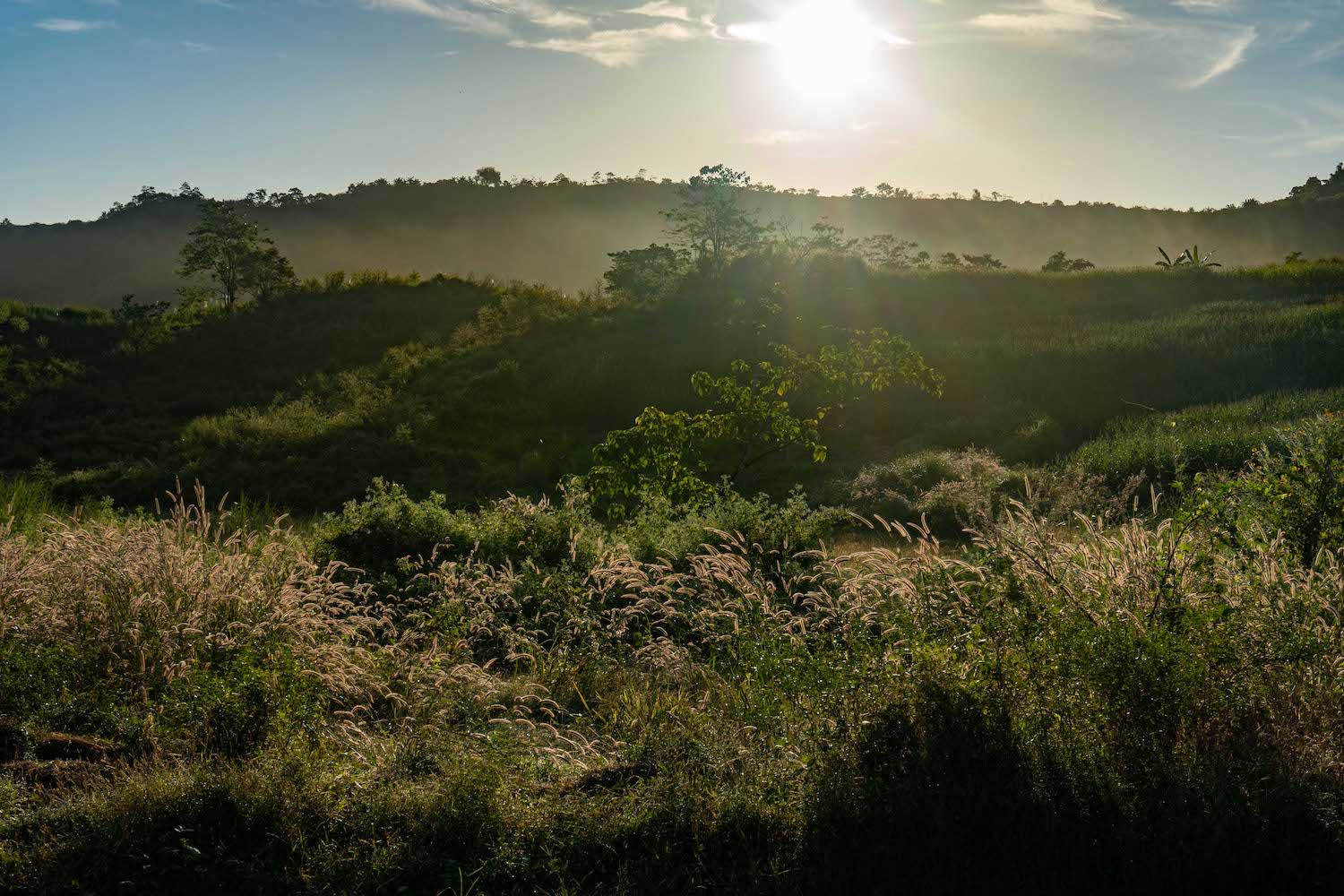Philippine environment defenders in the crosshairs of red-taggers
Red-tagging of individuals and groups have led to illegal arrests, harassment, and extra-judicial killings

At exactly 7p.m., a member of the Aeta tribe in the Philippines’ Central Luzon region, called everyone to prayer.
Families emerged from huts and gathered inside a chapel in the village of Sapang Kawayan, a remote tribal settlement in Capas, Tarlac province.
The faint noise from the construction site made its way into the chapel, reminding the people of the “monster” that is slowly encroaching into their land.

An Aeta woman shows one of the construction sites near her hut in Sitio Alli, in Capas town, Tarlac. She and her husband lost about four hectares of farm to the development project. (Photo by Bernice Beltran)
An Aeta woman shows one of the construction sites near her hut in Sitio Alli, in Capas town, Tarlac. She and her husband lost about four hectares of farm to the development project. (Photo by Bernice Beltran)
Background photo: Farms surround a dirt road that connects the villages of Sapang Kawayan and Binyayan. (Photo by Bernice Beltran)
Petronilla Capiz-Munoz, known as “Apung Pet” to her tribe, said she sought help from the local government about the threat of the New Clark City project to her tribe.
But the government person who was tasked to help the community was tagged as a communist, like many other activists who voiced their concern about human rights.

One of the sports facilities inside the New Clark City. (Photo by Bernice Beltran)
One of the sports facilities inside the New Clark City. (Photo by Bernice Beltran)
Since 2016, Pia Montalban, a human rights officer in the local government of Tarlac, held dialogues in areas affected by the government’s “development project.”
She received and heard the complaints from the communities.
One day, some time in 2018, she was surprised to see the words "NPA supporter" below her name hand-painted on a piece of cloth in her office.
The “NPA,” or the New People's Army, is the armed wing of the underground Communist Party of the Philippines, which was declared a terrorist organization by Philippine President Rodrigo Duterte in 2017.
Montalban was afraid, but she continued to help Apung Pet and linked the woman to a lawyer.
Background photo: The view of the plains and hills from the tribal settlement in Sapang Kawayan. (Photographed in 2019 by Bernice Beltran.)


Fighting for the environment kills
In 2018, the Philippine government released a list of 600 “terrorists,” many of whom are human rights activists and environment defenders.
One of those in the list is Joan Carling, a UN “Champions of the Earth” awardee and a member of the board of the group Indigenous Peoples Rights International.
The Philippines’ Commission on Human Rights defines red-tagging as “an act of state actors, particularly law enforcement agencies, to publicly brand individuals, groups, or institutions as affiliated to communist or leftist terrorists.”

A barracks inside the New Clark City complex, in Capas, Tarlac. (Photograph taken in 2019 by Bernice Beltran)
A barracks inside the New Clark City complex, in Capas, Tarlac. (Photograph taken in 2019 by Bernice Beltran)
In December 2020, environment group Kalikasan People’s Network for the Environment raised the alarm over the “red-tagging” of some of its members.
Red-tagging of individuals and groups in the Philippines have led to illegal arrests, harassment, and extra-judicial killings in recent months.
Montalban, Carling, and the group Kalikasan PNE have one thing in common: they opposed projects and policies that “harm nature and the communities that rely on it.”
Carling noted that whenever tribal people oppose government projects, the prevailing narrative of indigenous peoples as “backward, illiterate, anti-development, or worse, criminals” would surface.
“It is easy for state forces to brand indigenous peoples as terrorists because they live in the forests and mountains where the communist rebels have also set camp,” said Carling.
“The narrative obscures the fact that the traditional governance of indigenous peoples and their sustainable lifestyle have helped conserve the rich biodiversity of the land,” she said.
Carling, who has been tagged as a terrorist for her advocacy for indigenous peoples’ rights, said she would not be surprised if her name reappears on another list with the passage of a new anti-terrorism law.
The Philippines’ new anti-terrorism law authorizes the warrantless arrest of groups or individuals involved in alleged “acts of terrorists.”
Although the new law exempts advocacies and humanitarian activities from the definition of “terrorism,” several human rights and environmental defenders have already been red-tagged.
And among those tagged are indigenous peoples and communities.
Background photo: A hut inside Sitio Sapang Kawayan, a tribal settlement in Capas town, Tarlac. (Photo by Bernice Beltran)
Development over people’s rights
The forest and the hills where the Aetas’ ancestors hunted, foraged, and farmed for centuries are now bare land dotted with mounds of sand, gravel, and dirt.
It is here where the 9,450-hectare “eco-friendly” metropolis called “New Clark City” will rise.
The government’s Bases and Conversion Development Authority said the project will “ease” the poorly-planned and densely-populated Metro Manila and generate jobs in Central Luzon region.
The new city will use “green energy resources” to power its public utilities.
But Leon Dulce, national coordinator of Kalikasan PNE, said the project will never be “eco-friendly.”
“The [contractors] bulldozed forested areas … and the displacement of the indigenous communities will negatively affect the ecosystem,” he said.
Apung Pet said the developers seemed not to have realized that “nature is more powerful than us.”
“Nature does not care if you are rich or poor. If we destroy it, it will punish us. If we nurture it, it will provide us food and water generously,” said the tribal leader.
She recalled how her tribe takes care of the environment and how the environment also takes care of the people.
“When one of us would catch a wild boar, we would share it with the entire clan,” she said. “If we kill every animal we see, then we will have nothing left in the future.”
The Aetas practice crop rotation, that is planting different crops sequentially on the same plot of land to improve soil health, optimize nutrients in the soil, and combat pest and weed pressure.
“God made sure that we have what we need to survive. In return, we must cultivate it,” she said. “That’s why you can’t separate us from this land.”
She said the reason why indigenous people seldom go to the hospital is because they have leaves, roots, and stems of plants to treat whatever ailments they have.
“This is the only land we have and we cannot afford to lose it,” said Apung Pet.
Background photo: Plants grow around the fences in a farm belonging to the Aeta and farming community in Capas, Tarlac. (Photograph taken in 2020 by Bernice Beltran)



Petronilla Capiz-Muñoz (Apung Pet) poses for a portrait before she heads to the fields to work. (Photo by Bernice Beltran)
Petronilla Capiz-Muñoz (Apung Pet) poses for a portrait before she heads to the fields to work. (Photo by Bernice Beltran)
Threatening the tribe
The Aetas have also been red-tagged.
Montalban, who continues to help the community even after leaving government service, said the red-tagging undermines efforts in asserting the indigenous people’s rights.
“We need to counter the government’s narrative,” said Carling. “We need to show evidence that the [anti-terrorism law] hinders our efforts to protect biodiversity.”
Several human rights activists and groups have filed petitions against the new law.
The Commission on Human Rights assured that it will ensure that the rights of individuals and groups who are tagged as terrorists will be protected.
Meanwhile, several of those tagged have already been killed.
In December, nine tribal people from the Tumandok tribe in the province of Panay in the central Philippines were killed by policemen and soldiers in separate raids.
They were tagged as “supporters” of communist rebels for protesting against a local dam project.
This report was produced with the support of
InterNews’ Earth Journalism Network.
Text and Photos by Bernice Beltran
Published March 23, 2021
© Copyright MMXXI LiCAS.news

Trucks pass by a dirt road inside the New Clark City complex. (Photo by Bernice Beltran)
Trucks pass by a dirt road inside the New Clark City complex. (Photo by Bernice Beltran)
